Case Study Analysis of Stroke Patient
VerifiedAdded on 2022/08/25
|12
|3093
|58
AI Summary
Contribute Materials
Your contribution can guide someone’s learning journey. Share your
documents today.
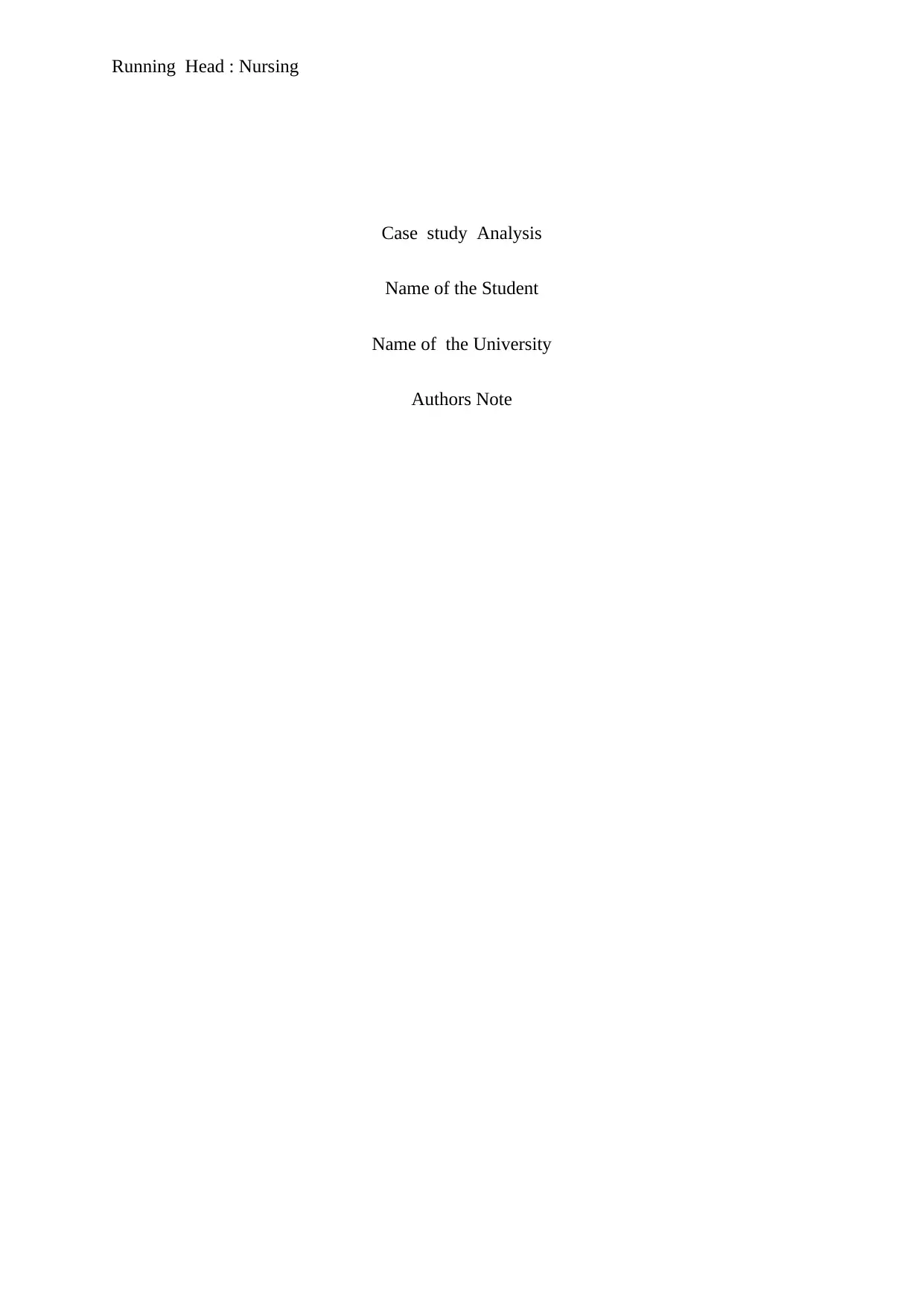
Running Head : Nursing
Case study Analysis
Name of the Student
Name of the University
Authors Note
Case study Analysis
Name of the Student
Name of the University
Authors Note
Secure Best Marks with AI Grader
Need help grading? Try our AI Grader for instant feedback on your assignments.
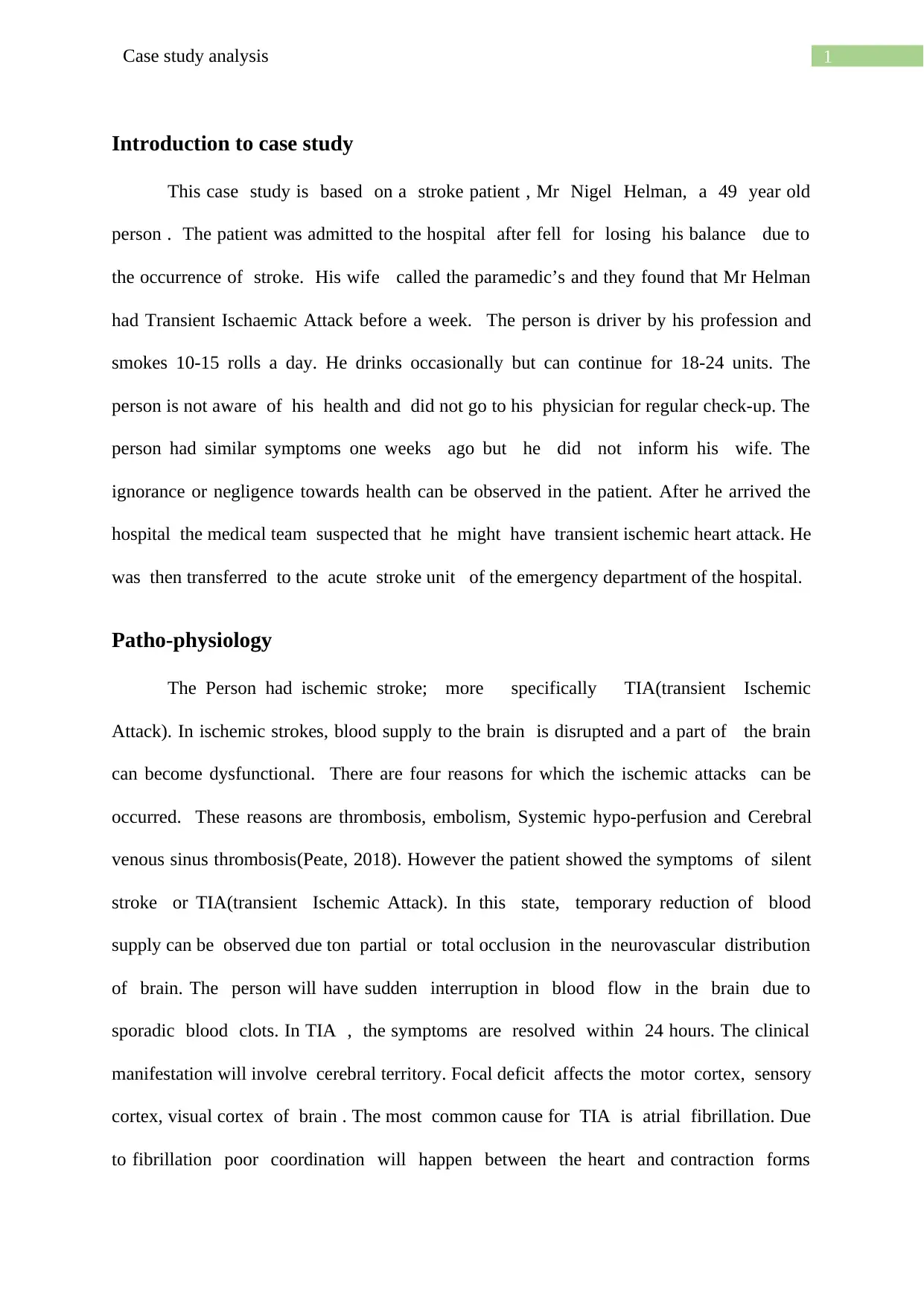
1Case study analysis
Introduction to case study
This case study is based on a stroke patient , Mr Nigel Helman, a 49 year old
person . The patient was admitted to the hospital after fell for losing his balance due to
the occurrence of stroke. His wife called the paramedic’s and they found that Mr Helman
had Transient Ischaemic Attack before a week. The person is driver by his profession and
smokes 10-15 rolls a day. He drinks occasionally but can continue for 18-24 units. The
person is not aware of his health and did not go to his physician for regular check-up. The
person had similar symptoms one weeks ago but he did not inform his wife. The
ignorance or negligence towards health can be observed in the patient. After he arrived the
hospital the medical team suspected that he might have transient ischemic heart attack. He
was then transferred to the acute stroke unit of the emergency department of the hospital.
Patho-physiology
The Person had ischemic stroke; more specifically TIA(transient Ischemic
Attack). In ischemic strokes, blood supply to the brain is disrupted and a part of the brain
can become dysfunctional. There are four reasons for which the ischemic attacks can be
occurred. These reasons are thrombosis, embolism, Systemic hypo-perfusion and Cerebral
venous sinus thrombosis(Peate, 2018). However the patient showed the symptoms of silent
stroke or TIA(transient Ischemic Attack). In this state, temporary reduction of blood
supply can be observed due ton partial or total occlusion in the neurovascular distribution
of brain. The person will have sudden interruption in blood flow in the brain due to
sporadic blood clots. In TIA , the symptoms are resolved within 24 hours. The clinical
manifestation will involve cerebral territory. Focal deficit affects the motor cortex, sensory
cortex, visual cortex of brain . The most common cause for TIA is atrial fibrillation. Due
to fibrillation poor coordination will happen between the heart and contraction forms
Introduction to case study
This case study is based on a stroke patient , Mr Nigel Helman, a 49 year old
person . The patient was admitted to the hospital after fell for losing his balance due to
the occurrence of stroke. His wife called the paramedic’s and they found that Mr Helman
had Transient Ischaemic Attack before a week. The person is driver by his profession and
smokes 10-15 rolls a day. He drinks occasionally but can continue for 18-24 units. The
person is not aware of his health and did not go to his physician for regular check-up. The
person had similar symptoms one weeks ago but he did not inform his wife. The
ignorance or negligence towards health can be observed in the patient. After he arrived the
hospital the medical team suspected that he might have transient ischemic heart attack. He
was then transferred to the acute stroke unit of the emergency department of the hospital.
Patho-physiology
The Person had ischemic stroke; more specifically TIA(transient Ischemic
Attack). In ischemic strokes, blood supply to the brain is disrupted and a part of the brain
can become dysfunctional. There are four reasons for which the ischemic attacks can be
occurred. These reasons are thrombosis, embolism, Systemic hypo-perfusion and Cerebral
venous sinus thrombosis(Peate, 2018). However the patient showed the symptoms of silent
stroke or TIA(transient Ischemic Attack). In this state, temporary reduction of blood
supply can be observed due ton partial or total occlusion in the neurovascular distribution
of brain. The person will have sudden interruption in blood flow in the brain due to
sporadic blood clots. In TIA , the symptoms are resolved within 24 hours. The clinical
manifestation will involve cerebral territory. Focal deficit affects the motor cortex, sensory
cortex, visual cortex of brain . The most common cause for TIA is atrial fibrillation. Due
to fibrillation poor coordination will happen between the heart and contraction forms
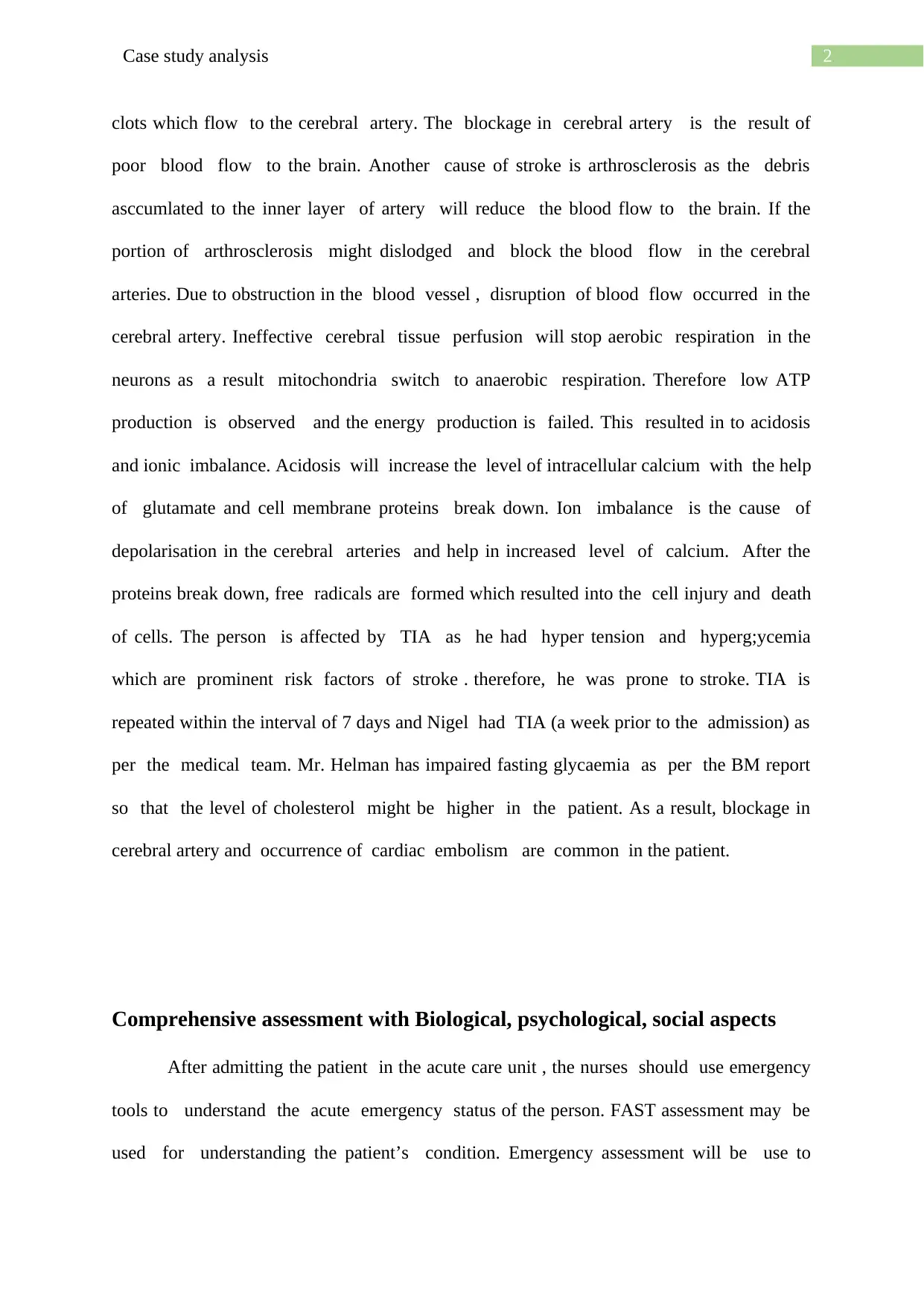
2Case study analysis
clots which flow to the cerebral artery. The blockage in cerebral artery is the result of
poor blood flow to the brain. Another cause of stroke is arthrosclerosis as the debris
asccumlated to the inner layer of artery will reduce the blood flow to the brain. If the
portion of arthrosclerosis might dislodged and block the blood flow in the cerebral
arteries. Due to obstruction in the blood vessel , disruption of blood flow occurred in the
cerebral artery. Ineffective cerebral tissue perfusion will stop aerobic respiration in the
neurons as a result mitochondria switch to anaerobic respiration. Therefore low ATP
production is observed and the energy production is failed. This resulted in to acidosis
and ionic imbalance. Acidosis will increase the level of intracellular calcium with the help
of glutamate and cell membrane proteins break down. Ion imbalance is the cause of
depolarisation in the cerebral arteries and help in increased level of calcium. After the
proteins break down, free radicals are formed which resulted into the cell injury and death
of cells. The person is affected by TIA as he had hyper tension and hyperg;ycemia
which are prominent risk factors of stroke . therefore, he was prone to stroke. TIA is
repeated within the interval of 7 days and Nigel had TIA (a week prior to the admission) as
per the medical team. Mr. Helman has impaired fasting glycaemia as per the BM report
so that the level of cholesterol might be higher in the patient. As a result, blockage in
cerebral artery and occurrence of cardiac embolism are common in the patient.
Comprehensive assessment with Biological, psychological, social aspects
After admitting the patient in the acute care unit , the nurses should use emergency
tools to understand the acute emergency status of the person. FAST assessment may be
used for understanding the patient’s condition. Emergency assessment will be use to
clots which flow to the cerebral artery. The blockage in cerebral artery is the result of
poor blood flow to the brain. Another cause of stroke is arthrosclerosis as the debris
asccumlated to the inner layer of artery will reduce the blood flow to the brain. If the
portion of arthrosclerosis might dislodged and block the blood flow in the cerebral
arteries. Due to obstruction in the blood vessel , disruption of blood flow occurred in the
cerebral artery. Ineffective cerebral tissue perfusion will stop aerobic respiration in the
neurons as a result mitochondria switch to anaerobic respiration. Therefore low ATP
production is observed and the energy production is failed. This resulted in to acidosis
and ionic imbalance. Acidosis will increase the level of intracellular calcium with the help
of glutamate and cell membrane proteins break down. Ion imbalance is the cause of
depolarisation in the cerebral arteries and help in increased level of calcium. After the
proteins break down, free radicals are formed which resulted into the cell injury and death
of cells. The person is affected by TIA as he had hyper tension and hyperg;ycemia
which are prominent risk factors of stroke . therefore, he was prone to stroke. TIA is
repeated within the interval of 7 days and Nigel had TIA (a week prior to the admission) as
per the medical team. Mr. Helman has impaired fasting glycaemia as per the BM report
so that the level of cholesterol might be higher in the patient. As a result, blockage in
cerebral artery and occurrence of cardiac embolism are common in the patient.
Comprehensive assessment with Biological, psychological, social aspects
After admitting the patient in the acute care unit , the nurses should use emergency
tools to understand the acute emergency status of the person. FAST assessment may be
used for understanding the patient’s condition. Emergency assessment will be use to
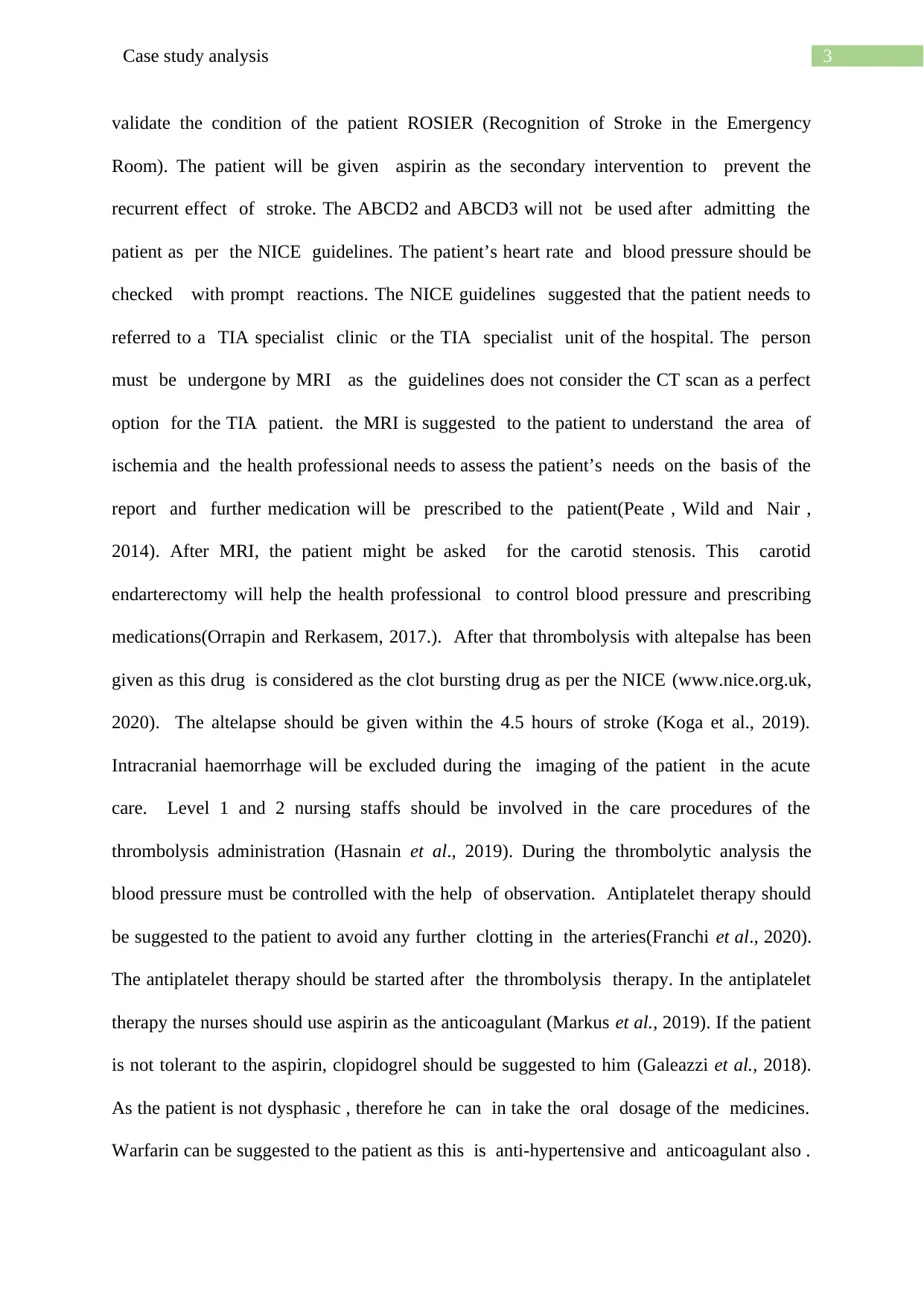
3Case study analysis
validate the condition of the patient ROSIER (Recognition of Stroke in the Emergency
Room). The patient will be given aspirin as the secondary intervention to prevent the
recurrent effect of stroke. The ABCD2 and ABCD3 will not be used after admitting the
patient as per the NICE guidelines. The patient’s heart rate and blood pressure should be
checked with prompt reactions. The NICE guidelines suggested that the patient needs to
referred to a TIA specialist clinic or the TIA specialist unit of the hospital. The person
must be undergone by MRI as the guidelines does not consider the CT scan as a perfect
option for the TIA patient. the MRI is suggested to the patient to understand the area of
ischemia and the health professional needs to assess the patient’s needs on the basis of the
report and further medication will be prescribed to the patient(Peate , Wild and Nair ,
2014). After MRI, the patient might be asked for the carotid stenosis. This carotid
endarterectomy will help the health professional to control blood pressure and prescribing
medications(Orrapin and Rerkasem, 2017.). After that thrombolysis with altepalse has been
given as this drug is considered as the clot bursting drug as per the NICE (www.nice.org.uk,
2020). The altelapse should be given within the 4.5 hours of stroke (Koga et al., 2019).
Intracranial haemorrhage will be excluded during the imaging of the patient in the acute
care. Level 1 and 2 nursing staffs should be involved in the care procedures of the
thrombolysis administration (Hasnain et al., 2019). During the thrombolytic analysis the
blood pressure must be controlled with the help of observation. Antiplatelet therapy should
be suggested to the patient to avoid any further clotting in the arteries(Franchi et al., 2020).
The antiplatelet therapy should be started after the thrombolysis therapy. In the antiplatelet
therapy the nurses should use aspirin as the anticoagulant (Markus et al., 2019). If the patient
is not tolerant to the aspirin, clopidogrel should be suggested to him (Galeazzi et al., 2018).
As the patient is not dysphasic , therefore he can in take the oral dosage of the medicines.
Warfarin can be suggested to the patient as this is anti-hypertensive and anticoagulant also .
validate the condition of the patient ROSIER (Recognition of Stroke in the Emergency
Room). The patient will be given aspirin as the secondary intervention to prevent the
recurrent effect of stroke. The ABCD2 and ABCD3 will not be used after admitting the
patient as per the NICE guidelines. The patient’s heart rate and blood pressure should be
checked with prompt reactions. The NICE guidelines suggested that the patient needs to
referred to a TIA specialist clinic or the TIA specialist unit of the hospital. The person
must be undergone by MRI as the guidelines does not consider the CT scan as a perfect
option for the TIA patient. the MRI is suggested to the patient to understand the area of
ischemia and the health professional needs to assess the patient’s needs on the basis of the
report and further medication will be prescribed to the patient(Peate , Wild and Nair ,
2014). After MRI, the patient might be asked for the carotid stenosis. This carotid
endarterectomy will help the health professional to control blood pressure and prescribing
medications(Orrapin and Rerkasem, 2017.). After that thrombolysis with altepalse has been
given as this drug is considered as the clot bursting drug as per the NICE (www.nice.org.uk,
2020). The altelapse should be given within the 4.5 hours of stroke (Koga et al., 2019).
Intracranial haemorrhage will be excluded during the imaging of the patient in the acute
care. Level 1 and 2 nursing staffs should be involved in the care procedures of the
thrombolysis administration (Hasnain et al., 2019). During the thrombolytic analysis the
blood pressure must be controlled with the help of observation. Antiplatelet therapy should
be suggested to the patient to avoid any further clotting in the arteries(Franchi et al., 2020).
The antiplatelet therapy should be started after the thrombolysis therapy. In the antiplatelet
therapy the nurses should use aspirin as the anticoagulant (Markus et al., 2019). If the patient
is not tolerant to the aspirin, clopidogrel should be suggested to him (Galeazzi et al., 2018).
As the patient is not dysphasic , therefore he can in take the oral dosage of the medicines.
Warfarin can be suggested to the patient as this is anti-hypertensive and anticoagulant also .
Secure Best Marks with AI Grader
Need help grading? Try our AI Grader for instant feedback on your assignments.
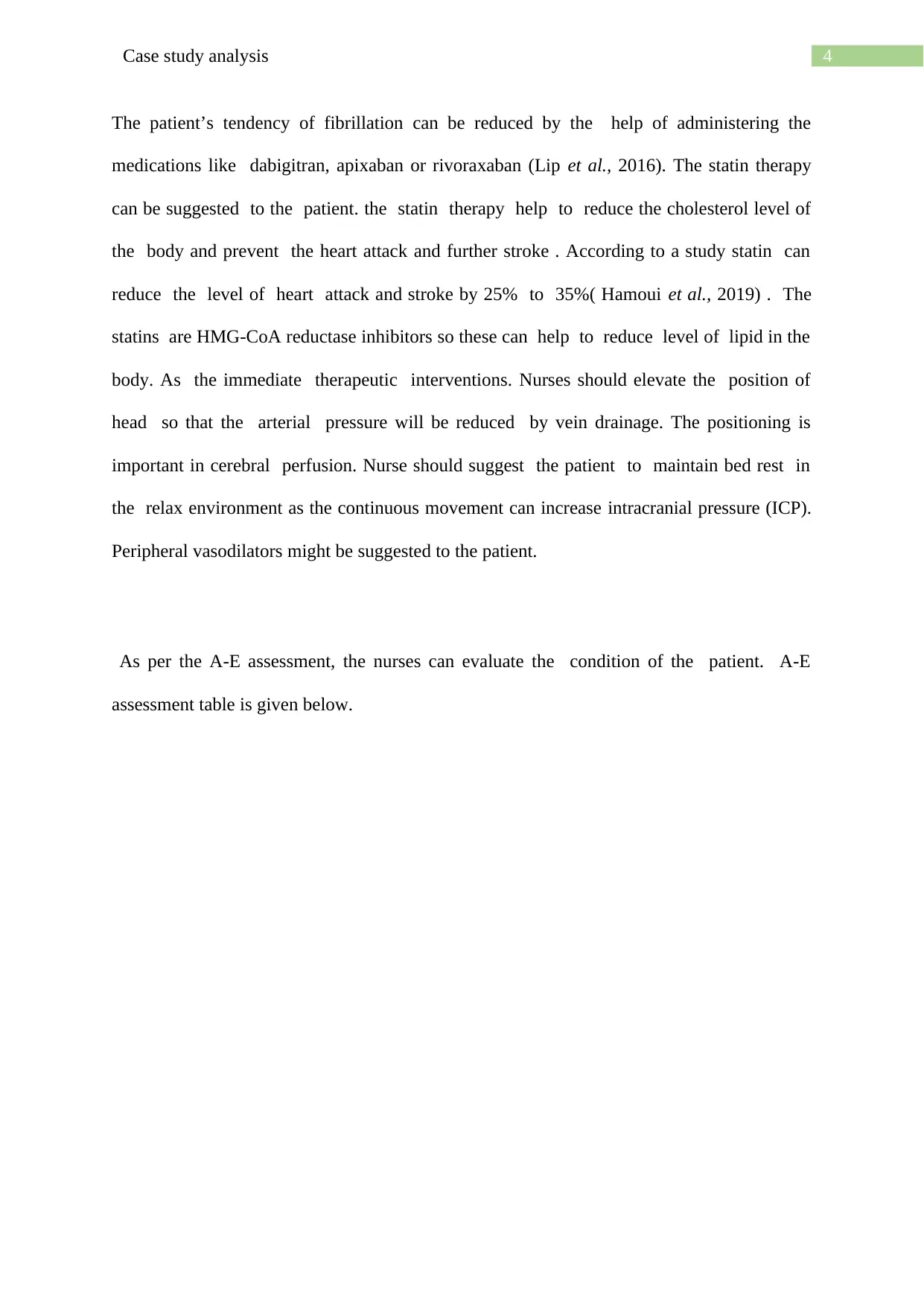
4Case study analysis
The patient’s tendency of fibrillation can be reduced by the help of administering the
medications like dabigitran, apixaban or rivoraxaban (Lip et al., 2016). The statin therapy
can be suggested to the patient. the statin therapy help to reduce the cholesterol level of
the body and prevent the heart attack and further stroke . According to a study statin can
reduce the level of heart attack and stroke by 25% to 35%( Hamoui et al., 2019) . The
statins are HMG-CoA reductase inhibitors so these can help to reduce level of lipid in the
body. As the immediate therapeutic interventions. Nurses should elevate the position of
head so that the arterial pressure will be reduced by vein drainage. The positioning is
important in cerebral perfusion. Nurse should suggest the patient to maintain bed rest in
the relax environment as the continuous movement can increase intracranial pressure (ICP).
Peripheral vasodilators might be suggested to the patient.
As per the A-E assessment, the nurses can evaluate the condition of the patient. A-E
assessment table is given below.
The patient’s tendency of fibrillation can be reduced by the help of administering the
medications like dabigitran, apixaban or rivoraxaban (Lip et al., 2016). The statin therapy
can be suggested to the patient. the statin therapy help to reduce the cholesterol level of
the body and prevent the heart attack and further stroke . According to a study statin can
reduce the level of heart attack and stroke by 25% to 35%( Hamoui et al., 2019) . The
statins are HMG-CoA reductase inhibitors so these can help to reduce level of lipid in the
body. As the immediate therapeutic interventions. Nurses should elevate the position of
head so that the arterial pressure will be reduced by vein drainage. The positioning is
important in cerebral perfusion. Nurse should suggest the patient to maintain bed rest in
the relax environment as the continuous movement can increase intracranial pressure (ICP).
Peripheral vasodilators might be suggested to the patient.
As per the A-E assessment, the nurses can evaluate the condition of the patient. A-E
assessment table is given below.

5Case study analysis
His respiratory rate is high after providing him ventilation the saturation level is
95% and his respiratory rate higher than the normal level which is 12-20 bpm. The initial
assessment shows that the person has high blood pressure and high blood glucose level. The
patient’s family needs to be more cautious about the health status of the person. As an effect
of TIA his face was drooped(Le May,(2015). Moreover his left side was impaired and he
could not move his left limbs. His speech also became slurred as per her wife’s statement.
The history of Nigel has shown that he is a smoker and consumes alcohol also.
A-airway airway clear
B-breathing Resp =24, oxygen sats 95% on air
C-circulation Pulse 84-regular pattern BP -152/88
Capillary refill normal .
D-disability AVPU -(ALERT)
GCS -15
NIH-Scale 11
Blood glucose -6.1-mmol.
E-Exposure Temperature 36.8
His respiratory rate is high after providing him ventilation the saturation level is
95% and his respiratory rate higher than the normal level which is 12-20 bpm. The initial
assessment shows that the person has high blood pressure and high blood glucose level. The
patient’s family needs to be more cautious about the health status of the person. As an effect
of TIA his face was drooped(Le May,(2015). Moreover his left side was impaired and he
could not move his left limbs. His speech also became slurred as per her wife’s statement.
The history of Nigel has shown that he is a smoker and consumes alcohol also.
A-airway airway clear
B-breathing Resp =24, oxygen sats 95% on air
C-circulation Pulse 84-regular pattern BP -152/88
Capillary refill normal .
D-disability AVPU -(ALERT)
GCS -15
NIH-Scale 11
Blood glucose -6.1-mmol.
E-Exposure Temperature 36.8
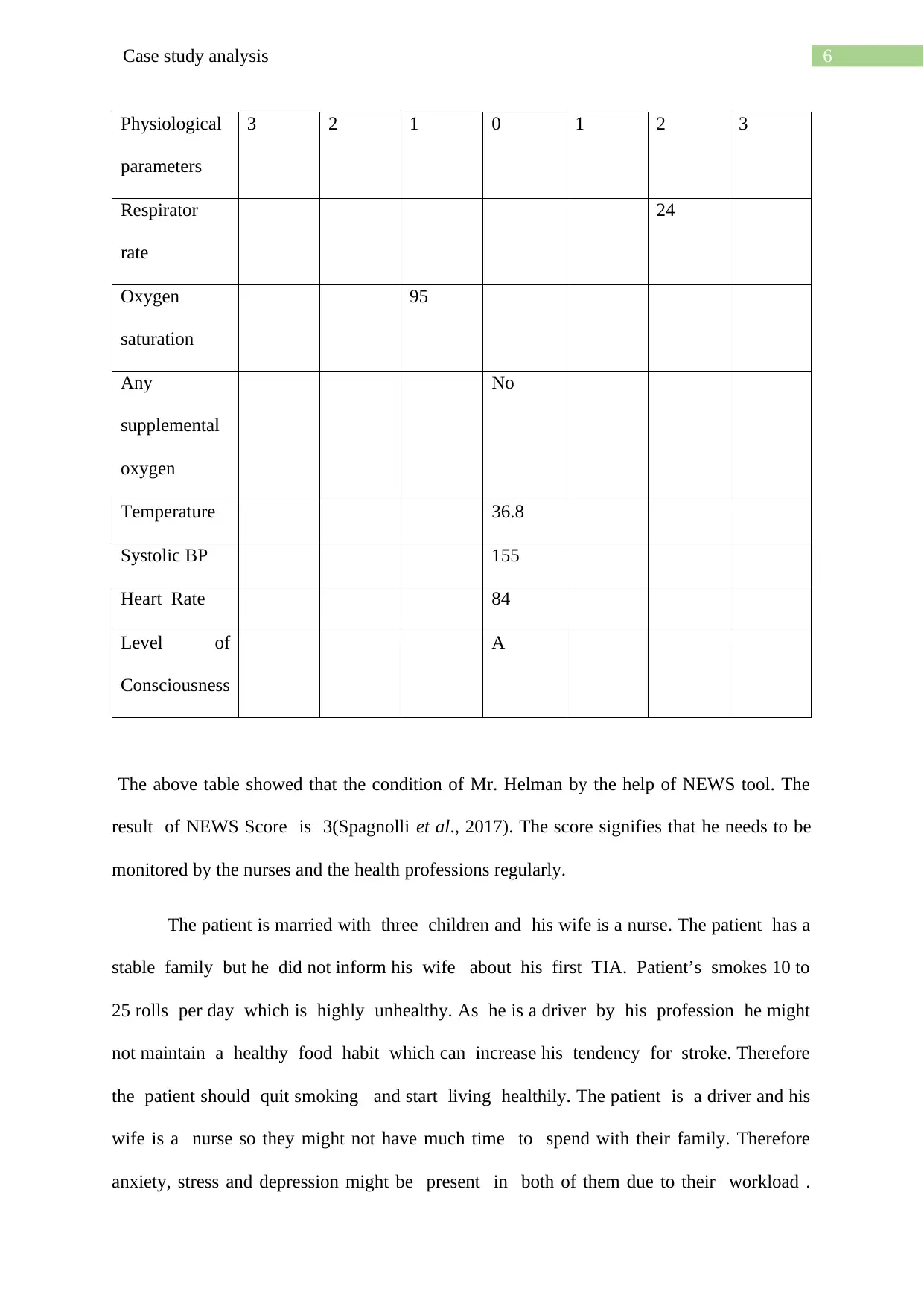
6Case study analysis
Physiological
parameters
3 2 1 0 1 2 3
Respirator
rate
24
Oxygen
saturation
95
Any
supplemental
oxygen
No
Temperature 36.8
Systolic BP 155
Heart Rate 84
Level of
Consciousness
A
The above table showed that the condition of Mr. Helman by the help of NEWS tool. The
result of NEWS Score is 3(Spagnolli et al., 2017). The score signifies that he needs to be
monitored by the nurses and the health professions regularly.
The patient is married with three children and his wife is a nurse. The patient has a
stable family but he did not inform his wife about his first TIA. Patient’s smokes 10 to
25 rolls per day which is highly unhealthy. As he is a driver by his profession he might
not maintain a healthy food habit which can increase his tendency for stroke. Therefore
the patient should quit smoking and start living healthily. The patient is a driver and his
wife is a nurse so they might not have much time to spend with their family. Therefore
anxiety, stress and depression might be present in both of them due to their workload .
Physiological
parameters
3 2 1 0 1 2 3
Respirator
rate
24
Oxygen
saturation
95
Any
supplemental
oxygen
No
Temperature 36.8
Systolic BP 155
Heart Rate 84
Level of
Consciousness
A
The above table showed that the condition of Mr. Helman by the help of NEWS tool. The
result of NEWS Score is 3(Spagnolli et al., 2017). The score signifies that he needs to be
monitored by the nurses and the health professions regularly.
The patient is married with three children and his wife is a nurse. The patient has a
stable family but he did not inform his wife about his first TIA. Patient’s smokes 10 to
25 rolls per day which is highly unhealthy. As he is a driver by his profession he might
not maintain a healthy food habit which can increase his tendency for stroke. Therefore
the patient should quit smoking and start living healthily. The patient is a driver and his
wife is a nurse so they might not have much time to spend with their family. Therefore
anxiety, stress and depression might be present in both of them due to their workload .
Paraphrase This Document
Need a fresh take? Get an instant paraphrase of this document with our AI Paraphraser
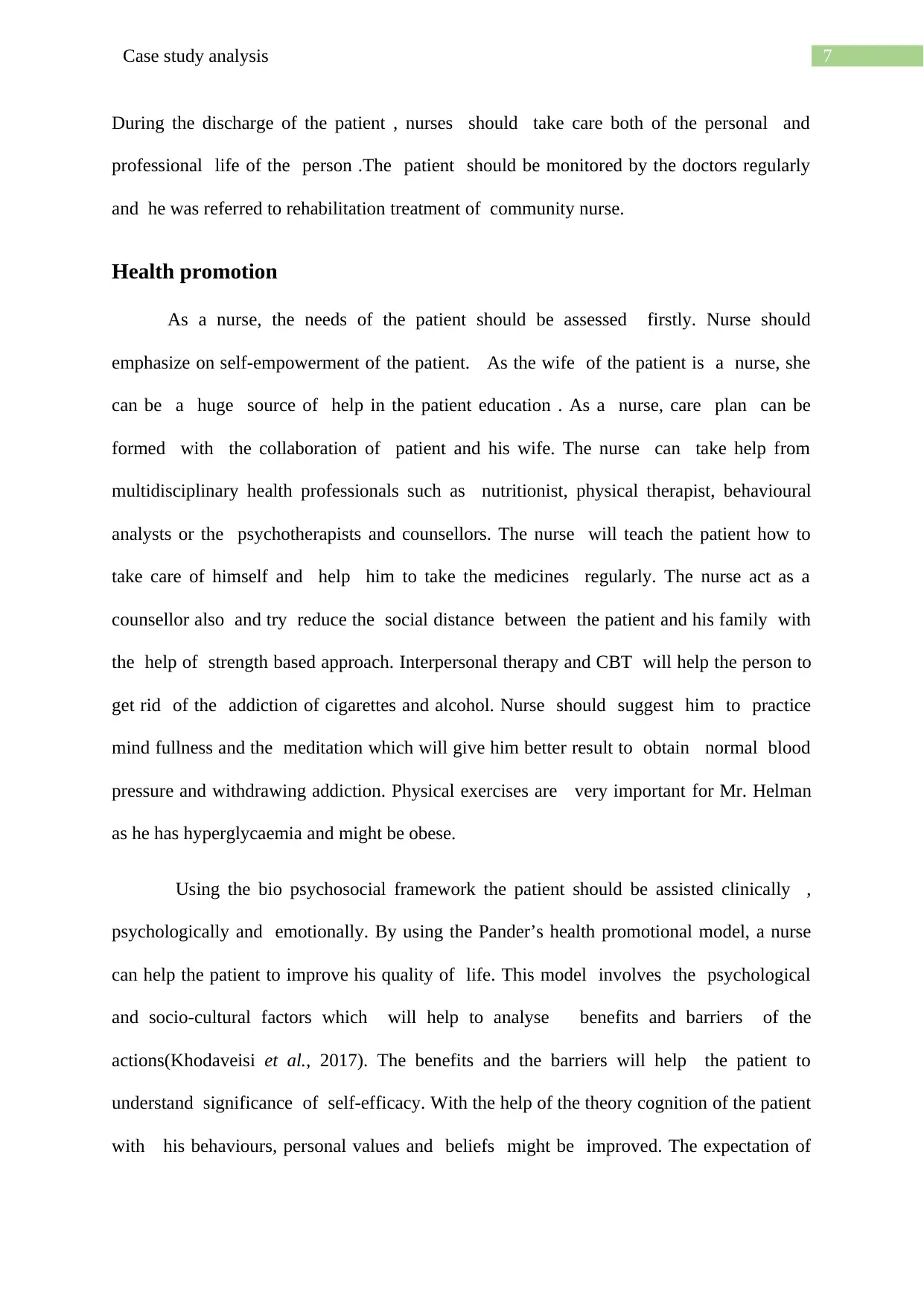
7Case study analysis
During the discharge of the patient , nurses should take care both of the personal and
professional life of the person .The patient should be monitored by the doctors regularly
and he was referred to rehabilitation treatment of community nurse.
Health promotion
As a nurse, the needs of the patient should be assessed firstly. Nurse should
emphasize on self-empowerment of the patient. As the wife of the patient is a nurse, she
can be a huge source of help in the patient education . As a nurse, care plan can be
formed with the collaboration of patient and his wife. The nurse can take help from
multidisciplinary health professionals such as nutritionist, physical therapist, behavioural
analysts or the psychotherapists and counsellors. The nurse will teach the patient how to
take care of himself and help him to take the medicines regularly. The nurse act as a
counsellor also and try reduce the social distance between the patient and his family with
the help of strength based approach. Interpersonal therapy and CBT will help the person to
get rid of the addiction of cigarettes and alcohol. Nurse should suggest him to practice
mind fullness and the meditation which will give him better result to obtain normal blood
pressure and withdrawing addiction. Physical exercises are very important for Mr. Helman
as he has hyperglycaemia and might be obese.
Using the bio psychosocial framework the patient should be assisted clinically ,
psychologically and emotionally. By using the Pander’s health promotional model, a nurse
can help the patient to improve his quality of life. This model involves the psychological
and socio-cultural factors which will help to analyse benefits and barriers of the
actions(Khodaveisi et al., 2017). The benefits and the barriers will help the patient to
understand significance of self-efficacy. With the help of the theory cognition of the patient
with his behaviours, personal values and beliefs might be improved. The expectation of
During the discharge of the patient , nurses should take care both of the personal and
professional life of the person .The patient should be monitored by the doctors regularly
and he was referred to rehabilitation treatment of community nurse.
Health promotion
As a nurse, the needs of the patient should be assessed firstly. Nurse should
emphasize on self-empowerment of the patient. As the wife of the patient is a nurse, she
can be a huge source of help in the patient education . As a nurse, care plan can be
formed with the collaboration of patient and his wife. The nurse can take help from
multidisciplinary health professionals such as nutritionist, physical therapist, behavioural
analysts or the psychotherapists and counsellors. The nurse will teach the patient how to
take care of himself and help him to take the medicines regularly. The nurse act as a
counsellor also and try reduce the social distance between the patient and his family with
the help of strength based approach. Interpersonal therapy and CBT will help the person to
get rid of the addiction of cigarettes and alcohol. Nurse should suggest him to practice
mind fullness and the meditation which will give him better result to obtain normal blood
pressure and withdrawing addiction. Physical exercises are very important for Mr. Helman
as he has hyperglycaemia and might be obese.
Using the bio psychosocial framework the patient should be assisted clinically ,
psychologically and emotionally. By using the Pander’s health promotional model, a nurse
can help the patient to improve his quality of life. This model involves the psychological
and socio-cultural factors which will help to analyse benefits and barriers of the
actions(Khodaveisi et al., 2017). The benefits and the barriers will help the patient to
understand significance of self-efficacy. With the help of the theory cognition of the patient
with his behaviours, personal values and beliefs might be improved. The expectation of
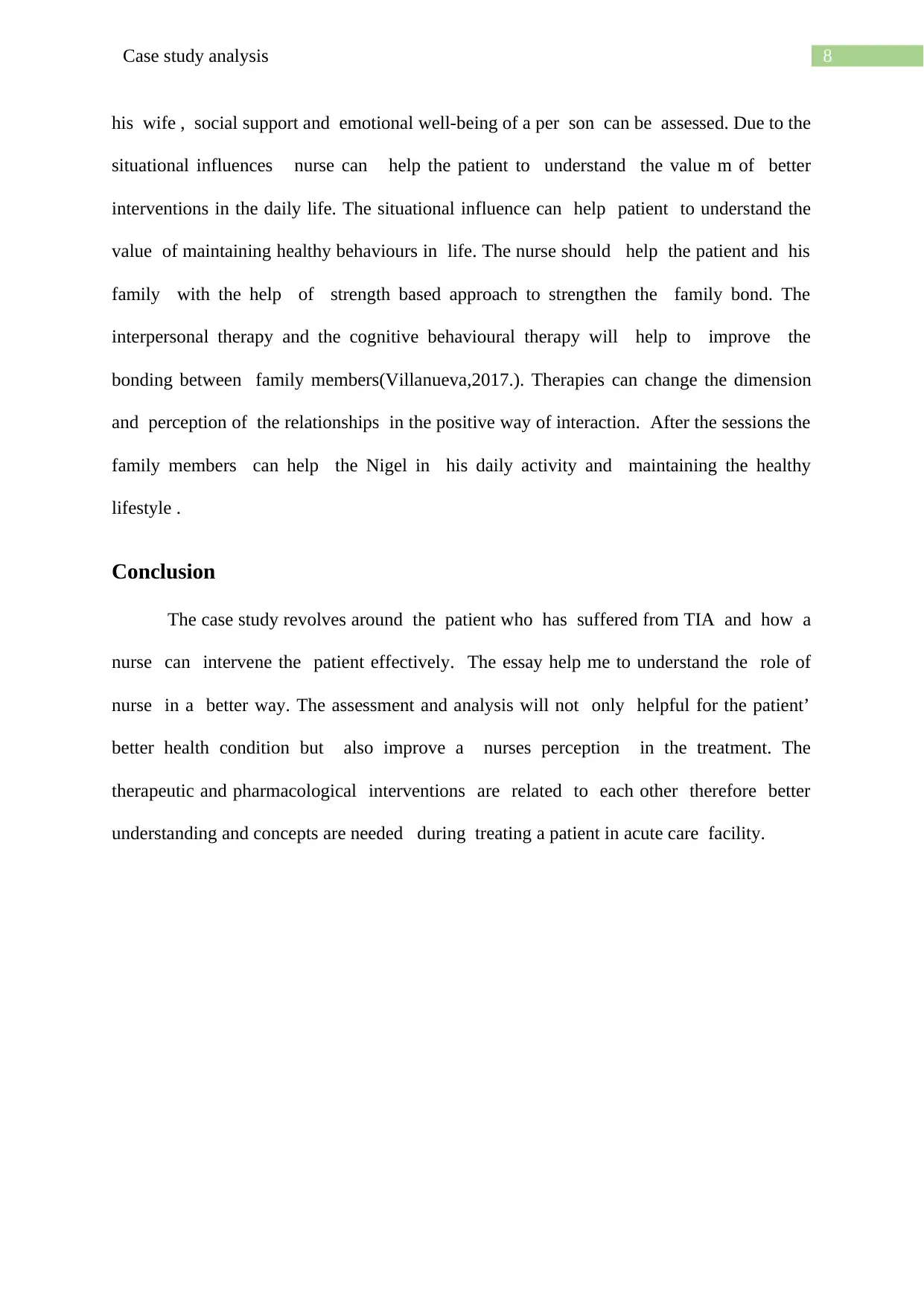
8Case study analysis
his wife , social support and emotional well-being of a per son can be assessed. Due to the
situational influences nurse can help the patient to understand the value m of better
interventions in the daily life. The situational influence can help patient to understand the
value of maintaining healthy behaviours in life. The nurse should help the patient and his
family with the help of strength based approach to strengthen the family bond. The
interpersonal therapy and the cognitive behavioural therapy will help to improve the
bonding between family members(Villanueva,2017.). Therapies can change the dimension
and perception of the relationships in the positive way of interaction. After the sessions the
family members can help the Nigel in his daily activity and maintaining the healthy
lifestyle .
Conclusion
The case study revolves around the patient who has suffered from TIA and how a
nurse can intervene the patient effectively. The essay help me to understand the role of
nurse in a better way. The assessment and analysis will not only helpful for the patient’
better health condition but also improve a nurses perception in the treatment. The
therapeutic and pharmacological interventions are related to each other therefore better
understanding and concepts are needed during treating a patient in acute care facility.
his wife , social support and emotional well-being of a per son can be assessed. Due to the
situational influences nurse can help the patient to understand the value m of better
interventions in the daily life. The situational influence can help patient to understand the
value of maintaining healthy behaviours in life. The nurse should help the patient and his
family with the help of strength based approach to strengthen the family bond. The
interpersonal therapy and the cognitive behavioural therapy will help to improve the
bonding between family members(Villanueva,2017.). Therapies can change the dimension
and perception of the relationships in the positive way of interaction. After the sessions the
family members can help the Nigel in his daily activity and maintaining the healthy
lifestyle .
Conclusion
The case study revolves around the patient who has suffered from TIA and how a
nurse can intervene the patient effectively. The essay help me to understand the role of
nurse in a better way. The assessment and analysis will not only helpful for the patient’
better health condition but also improve a nurses perception in the treatment. The
therapeutic and pharmacological interventions are related to each other therefore better
understanding and concepts are needed during treating a patient in acute care facility.
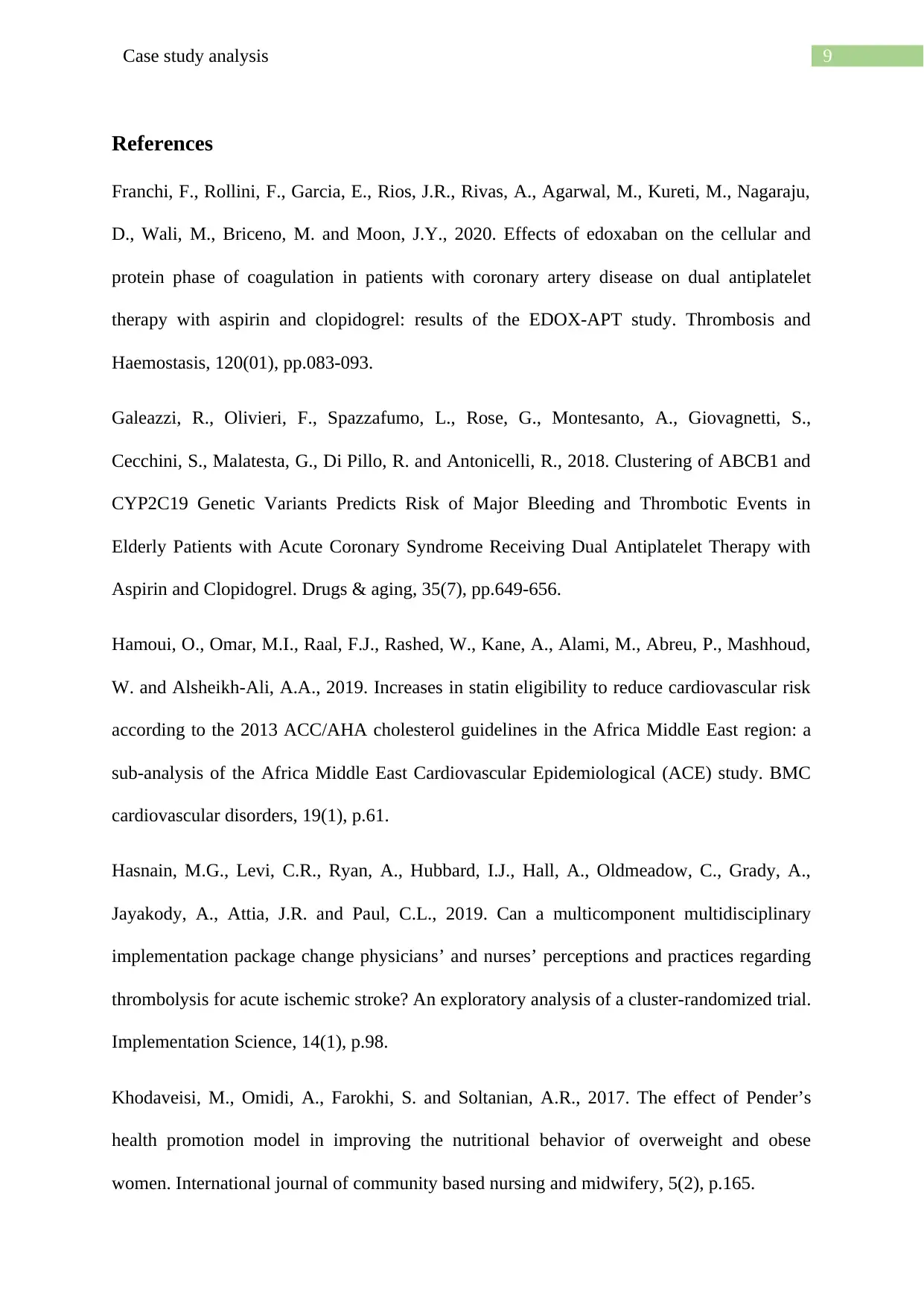
9Case study analysis
References
Franchi, F., Rollini, F., Garcia, E., Rios, J.R., Rivas, A., Agarwal, M., Kureti, M., Nagaraju,
D., Wali, M., Briceno, M. and Moon, J.Y., 2020. Effects of edoxaban on the cellular and
protein phase of coagulation in patients with coronary artery disease on dual antiplatelet
therapy with aspirin and clopidogrel: results of the EDOX-APT study. Thrombosis and
Haemostasis, 120(01), pp.083-093.
Galeazzi, R., Olivieri, F., Spazzafumo, L., Rose, G., Montesanto, A., Giovagnetti, S.,
Cecchini, S., Malatesta, G., Di Pillo, R. and Antonicelli, R., 2018. Clustering of ABCB1 and
CYP2C19 Genetic Variants Predicts Risk of Major Bleeding and Thrombotic Events in
Elderly Patients with Acute Coronary Syndrome Receiving Dual Antiplatelet Therapy with
Aspirin and Clopidogrel. Drugs & aging, 35(7), pp.649-656.
Hamoui, O., Omar, M.I., Raal, F.J., Rashed, W., Kane, A., Alami, M., Abreu, P., Mashhoud,
W. and Alsheikh-Ali, A.A., 2019. Increases in statin eligibility to reduce cardiovascular risk
according to the 2013 ACC/AHA cholesterol guidelines in the Africa Middle East region: a
sub-analysis of the Africa Middle East Cardiovascular Epidemiological (ACE) study. BMC
cardiovascular disorders, 19(1), p.61.
Hasnain, M.G., Levi, C.R., Ryan, A., Hubbard, I.J., Hall, A., Oldmeadow, C., Grady, A.,
Jayakody, A., Attia, J.R. and Paul, C.L., 2019. Can a multicomponent multidisciplinary
implementation package change physicians’ and nurses’ perceptions and practices regarding
thrombolysis for acute ischemic stroke? An exploratory analysis of a cluster-randomized trial.
Implementation Science, 14(1), p.98.
Khodaveisi, M., Omidi, A., Farokhi, S. and Soltanian, A.R., 2017. The effect of Pender’s
health promotion model in improving the nutritional behavior of overweight and obese
women. International journal of community based nursing and midwifery, 5(2), p.165.
References
Franchi, F., Rollini, F., Garcia, E., Rios, J.R., Rivas, A., Agarwal, M., Kureti, M., Nagaraju,
D., Wali, M., Briceno, M. and Moon, J.Y., 2020. Effects of edoxaban on the cellular and
protein phase of coagulation in patients with coronary artery disease on dual antiplatelet
therapy with aspirin and clopidogrel: results of the EDOX-APT study. Thrombosis and
Haemostasis, 120(01), pp.083-093.
Galeazzi, R., Olivieri, F., Spazzafumo, L., Rose, G., Montesanto, A., Giovagnetti, S.,
Cecchini, S., Malatesta, G., Di Pillo, R. and Antonicelli, R., 2018. Clustering of ABCB1 and
CYP2C19 Genetic Variants Predicts Risk of Major Bleeding and Thrombotic Events in
Elderly Patients with Acute Coronary Syndrome Receiving Dual Antiplatelet Therapy with
Aspirin and Clopidogrel. Drugs & aging, 35(7), pp.649-656.
Hamoui, O., Omar, M.I., Raal, F.J., Rashed, W., Kane, A., Alami, M., Abreu, P., Mashhoud,
W. and Alsheikh-Ali, A.A., 2019. Increases in statin eligibility to reduce cardiovascular risk
according to the 2013 ACC/AHA cholesterol guidelines in the Africa Middle East region: a
sub-analysis of the Africa Middle East Cardiovascular Epidemiological (ACE) study. BMC
cardiovascular disorders, 19(1), p.61.
Hasnain, M.G., Levi, C.R., Ryan, A., Hubbard, I.J., Hall, A., Oldmeadow, C., Grady, A.,
Jayakody, A., Attia, J.R. and Paul, C.L., 2019. Can a multicomponent multidisciplinary
implementation package change physicians’ and nurses’ perceptions and practices regarding
thrombolysis for acute ischemic stroke? An exploratory analysis of a cluster-randomized trial.
Implementation Science, 14(1), p.98.
Khodaveisi, M., Omidi, A., Farokhi, S. and Soltanian, A.R., 2017. The effect of Pender’s
health promotion model in improving the nutritional behavior of overweight and obese
women. International journal of community based nursing and midwifery, 5(2), p.165.
Secure Best Marks with AI Grader
Need help grading? Try our AI Grader for instant feedback on your assignments.
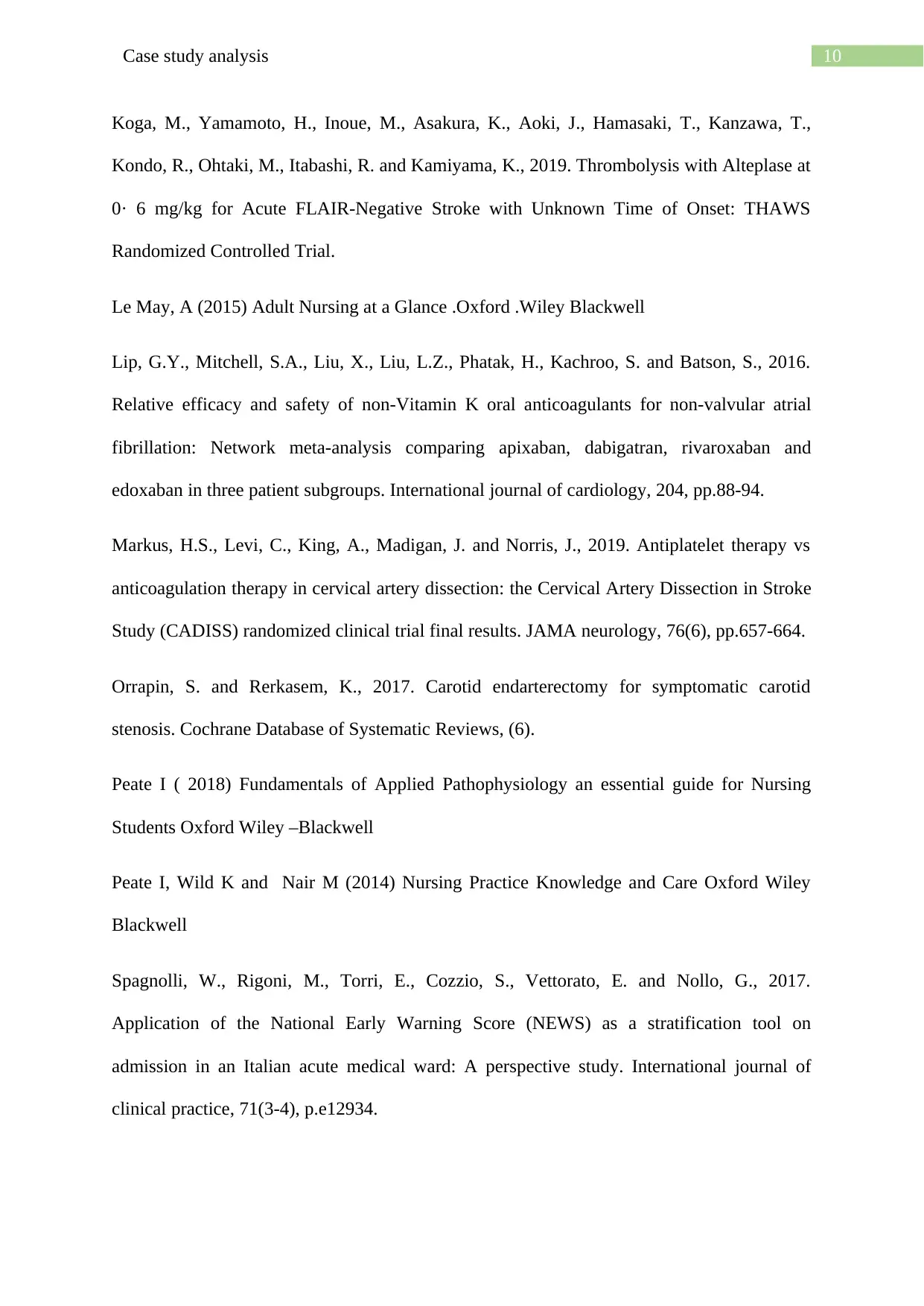
10Case study analysis
Koga, M., Yamamoto, H., Inoue, M., Asakura, K., Aoki, J., Hamasaki, T., Kanzawa, T.,
Kondo, R., Ohtaki, M., Itabashi, R. and Kamiyama, K., 2019. Thrombolysis with Alteplase at
0· 6 mg/kg for Acute FLAIR-Negative Stroke with Unknown Time of Onset: THAWS
Randomized Controlled Trial.
Le May, A (2015) Adult Nursing at a Glance .Oxford .Wiley Blackwell
Lip, G.Y., Mitchell, S.A., Liu, X., Liu, L.Z., Phatak, H., Kachroo, S. and Batson, S., 2016.
Relative efficacy and safety of non-Vitamin K oral anticoagulants for non-valvular atrial
fibrillation: Network meta-analysis comparing apixaban, dabigatran, rivaroxaban and
edoxaban in three patient subgroups. International journal of cardiology, 204, pp.88-94.
Markus, H.S., Levi, C., King, A., Madigan, J. and Norris, J., 2019. Antiplatelet therapy vs
anticoagulation therapy in cervical artery dissection: the Cervical Artery Dissection in Stroke
Study (CADISS) randomized clinical trial final results. JAMA neurology, 76(6), pp.657-664.
Orrapin, S. and Rerkasem, K., 2017. Carotid endarterectomy for symptomatic carotid
stenosis. Cochrane Database of Systematic Reviews, (6).
Peate I ( 2018) Fundamentals of Applied Pathophysiology an essential guide for Nursing
Students Oxford Wiley –Blackwell
Peate I, Wild K and Nair M (2014) Nursing Practice Knowledge and Care Oxford Wiley
Blackwell
Spagnolli, W., Rigoni, M., Torri, E., Cozzio, S., Vettorato, E. and Nollo, G., 2017.
Application of the National Early Warning Score (NEWS) as a stratification tool on
admission in an Italian acute medical ward: A perspective study. International journal of
clinical practice, 71(3-4), p.e12934.
Koga, M., Yamamoto, H., Inoue, M., Asakura, K., Aoki, J., Hamasaki, T., Kanzawa, T.,
Kondo, R., Ohtaki, M., Itabashi, R. and Kamiyama, K., 2019. Thrombolysis with Alteplase at
0· 6 mg/kg for Acute FLAIR-Negative Stroke with Unknown Time of Onset: THAWS
Randomized Controlled Trial.
Le May, A (2015) Adult Nursing at a Glance .Oxford .Wiley Blackwell
Lip, G.Y., Mitchell, S.A., Liu, X., Liu, L.Z., Phatak, H., Kachroo, S. and Batson, S., 2016.
Relative efficacy and safety of non-Vitamin K oral anticoagulants for non-valvular atrial
fibrillation: Network meta-analysis comparing apixaban, dabigatran, rivaroxaban and
edoxaban in three patient subgroups. International journal of cardiology, 204, pp.88-94.
Markus, H.S., Levi, C., King, A., Madigan, J. and Norris, J., 2019. Antiplatelet therapy vs
anticoagulation therapy in cervical artery dissection: the Cervical Artery Dissection in Stroke
Study (CADISS) randomized clinical trial final results. JAMA neurology, 76(6), pp.657-664.
Orrapin, S. and Rerkasem, K., 2017. Carotid endarterectomy for symptomatic carotid
stenosis. Cochrane Database of Systematic Reviews, (6).
Peate I ( 2018) Fundamentals of Applied Pathophysiology an essential guide for Nursing
Students Oxford Wiley –Blackwell
Peate I, Wild K and Nair M (2014) Nursing Practice Knowledge and Care Oxford Wiley
Blackwell
Spagnolli, W., Rigoni, M., Torri, E., Cozzio, S., Vettorato, E. and Nollo, G., 2017.
Application of the National Early Warning Score (NEWS) as a stratification tool on
admission in an Italian acute medical ward: A perspective study. International journal of
clinical practice, 71(3-4), p.e12934.
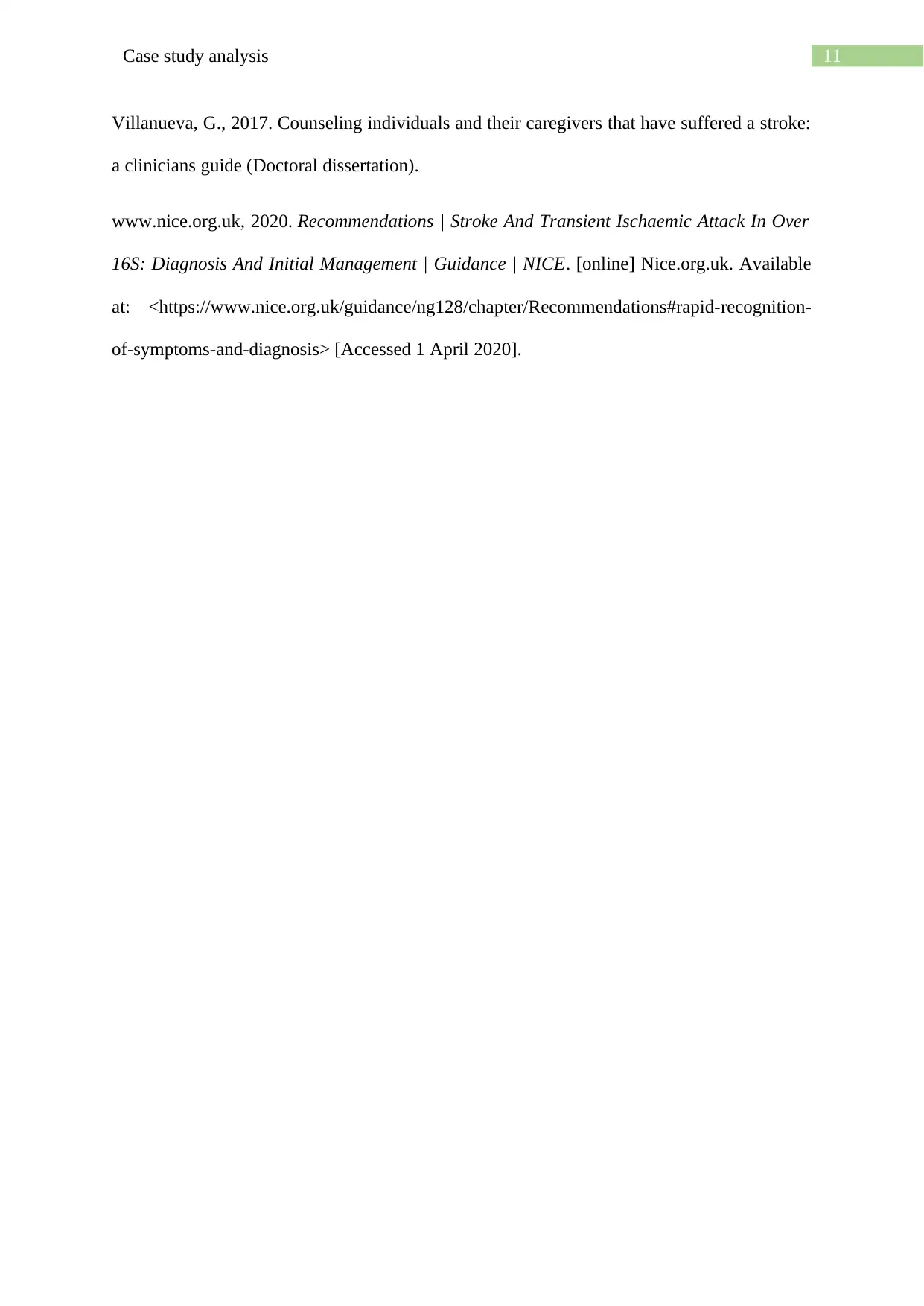
11Case study analysis
Villanueva, G., 2017. Counseling individuals and their caregivers that have suffered a stroke:
a clinicians guide (Doctoral dissertation).
www.nice.org.uk, 2020. Recommendations | Stroke And Transient Ischaemic Attack In Over
16S: Diagnosis And Initial Management | Guidance | NICE. [online] Nice.org.uk. Available
at: <https://www.nice.org.uk/guidance/ng128/chapter/Recommendations#rapid-recognition-
of-symptoms-and-diagnosis> [Accessed 1 April 2020].
Villanueva, G., 2017. Counseling individuals and their caregivers that have suffered a stroke:
a clinicians guide (Doctoral dissertation).
www.nice.org.uk, 2020. Recommendations | Stroke And Transient Ischaemic Attack In Over
16S: Diagnosis And Initial Management | Guidance | NICE. [online] Nice.org.uk. Available
at: <https://www.nice.org.uk/guidance/ng128/chapter/Recommendations#rapid-recognition-
of-symptoms-and-diagnosis> [Accessed 1 April 2020].
1 out of 12
Related Documents
Your All-in-One AI-Powered Toolkit for Academic Success.
+13062052269
info@desklib.com
Available 24*7 on WhatsApp / Email
![[object Object]](/_next/static/media/star-bottom.7253800d.svg)
Unlock your academic potential
© 2024 | Zucol Services PVT LTD | All rights reserved.





